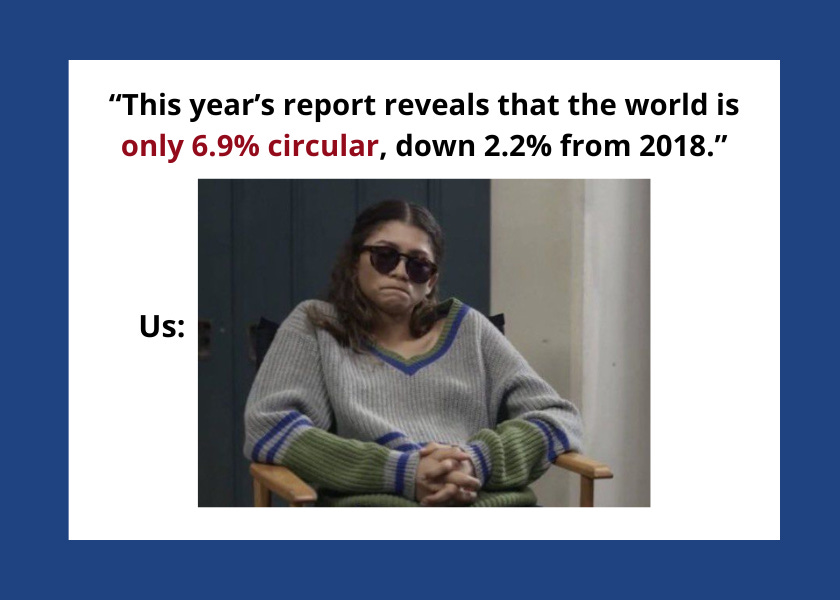Be in the Loop: Key findings from the Circularity Gap Report 2025
Our world as of today is only 6.9% circular, and we need to act fast

Hello!
This week’s newsletter sheds light on key findings and hard facts presented in the hottest topic in the circularity space at the moment: the Circularity Gap Report 2025 (CGR®).
This year’s CGR was launched at the World Circular Economy Forum (WCEF) 2025 in São Paulo from May 13 to 16 last week.
Powered by global impact organization Circle Economy, the CGR promotes a circular economy with data-backed insights and actionable solutions.
Back when it was launched in 2018, the report introduced the first global metric for circularity and revealed that the world was only 9.1% circular.
Since then, the report has become a valuable tool for tracking circularity progress and guiding decision-makers toward sustainable practices worldwide.
Let’s dive into this year’s report, shall we?
Mind the (Circularity) Gap, Please!
Despite an increasing awareness of circularity and more policies supporting a circular economy, progress has not only stalled but continues to decline.
As reported in the latest CGR, global circularity has decreased to 6.9% — a 2.2% drop from Circle Economy’s first calculation in 2018.
What does this mean, and why is it so alarming?
This means that only 6.9% of all the materials we use globally are being reused or recycled. The rest, over a staggering 93%, are derived from new resources and eventually end up as waste or emissions.
In even simpler terms, society is biting off more than it can chew and spitting out an overwhelming amount of waste that ends up polluting our air, oceans, and landfills.
This backward trend highlights the urgency of expanding access to CGR data and insights, investigating the root causes of this decline, and scaling support for decision-makers in driving systemic change.
Key Findings from the Circularity Gap Report 2025
📉 Circularity Metric is Declining
Circularity dropped from 7.2% to 6.9%.
Global material extraction has tripled in 50 years, now exceeding 100 billion tonnes annually.
Recycling untapped waste streams could boost circularity to approximately 25%.
🌽 Biomass Utilization
Carbon-neutral biomass, organic materials like plants or agricultural waste that don't add extra CO₂ to the atmosphere, accounts for 21.5% of global material use. This is significant for reducing climate impacts, provided that it’s managed sustainably.
Unsustainable practices—such as deforestation for agriculture, overfishing, intensive monoculture farming, and excessive use of chemical inputs—degrade ecosystems. This necessitates a shift to regenerative, plant-based systems.
🔋 Fossil Fuel Dependency
Fossil fuel extraction surged to 15.8 billion tonnes, comprising 13.3% of material flows.
Energy-related emissions account for 73% of global greenhouse gases, highlighting the urgency of transitioning to renewable energy use.
🏙️ Rapid Stock Accumulation
Stocks like buildings and infrastructure represent 38% of material flows, which are largely driven by urbanization.
Circular design in stocks can expand material recovery and reduce reliance on virgin materials.
Key Strategies for All, From Institutions to Individuals
For Governments:
Set clear global and national circular economy targets.
Redirect subsidies from linear to circular activities.
Promote international collaboration for resource management.
👉 Read our circular economy deep dives on the Philippines, Thailand, Malaysia, Vietnam, and Singapore to learn about these countries’ circularity initiativesFor Businesses:
Embrace circular design principles for durability and recycling.
Transition to service-based models and closed-loop systems.
Collaborate across sectors to scale circularity.
👉 In Southeast Asia: read about startups that reimagine waste, top circular economy startups to watch out for, and industries circling back to sustainable practicesFor Consumers and Communities:
Advocate for systemic change.
Support businesses prioritizing sustainability.
Adopt sustainable consumption practices.
👉 Read our think pieces on greenwashing, the antitheses of mindful consumption, and how to muster Circular Economy conversations without alienating everyone in the roomToo Long; Didn’t Read? What You Need to Know
The current state of material extraction, waste generation, and emissions remain vastly misaligned with sustainable development goals.
Urgent, radical action is needed to reverse these trends, entailing society to (1) resist antiquated ways of operating, and (2) rewire current systems to make them circular and sustainable.
To foster a truly circular economy, we must:
🌽 Manage biomass sustainably
🏠 Unlock circular potential in buildings and infrastructure
🔋 Minimize fossil fuel use
♻️ Reduce the extraction and disposal of non-renewable materials
📣 Be responsible and informed citizens by supporting leaders, projects, and movements that bolster and are aligned with circularity principles
Read the full Circularity Gap Report 2025 here. Join the conversation by sharing this newsletter with a friend, commenting down below, and following us on LinkedIn and tagging us with your thoughts.
Yours in collective action and closing the loop,
SEArcularity



Hi, thank you for sharing these valuable statistics and showing us the current reality of circularity.
I wanted to share with you a housing architecture I am developing that would help us in our quest to achieve degrowth and reduce our material waste.
I left the link to the post in your inbox. You can check it out when you have time and we can discuss afterwards.